Abstract
Concanavalin A, a protein isolated from jack beans, exhibits several important biological properties, all of which are related to its ability to bind and precipitate specific polysaccharides. Concanavalin A is a dimer at pH 5.6, and has one transition-metal and one calcium-ion binding site per monomer unit of molecular weight 27,000. Both metal-ion sites must be occupied for the protein to be active. It is of interest to determine the role of the transition metal ion in Concanavalin A and its relationship to the sugar binding activity of the protein.
We report the magnetic field and temperature dependences of the spin-lattice magnetic relaxation rates of solvent protons in aqueous solutions of zinc and manganese derivatives of Concanavalin A, and the influence of monosaccharide binding on these rates. The results of a leastsquares fit of the data to the theory, with five adjustable parameters, indicate that there is one rapidly exchanging water molecule ligand on the Mn2+ ion, with a residence lifetime of 2.5 μsec at 25°, and with its protons 0.27 nm (2.7 Å) from the Mn2+ ion. We find that at low magnetic fields (proton Larmor frequencies below about 10 MHz), the correlation time for the dipolar interaction between the Mn2+ electronic spin moment and the protons on the water ligand is the spin-lattice relaxation time τS of the Mn2+ moment, but that at higher magnetic fields the correlation time for the dipolar interaction is determined by the Brownian rotational tumbling of the protein, because of the substantial variation of τS with magnetic field. Monosaccharide binding to manganese Concanavalin A has little effect on the relaxation rates of solvent protons, a result that indicates that the sugars do not bind directly to the transition metal in the protein.
Keywords: lectin, metalloenzymes, NMR, Mn2+-H2O ligand
Full text
PDF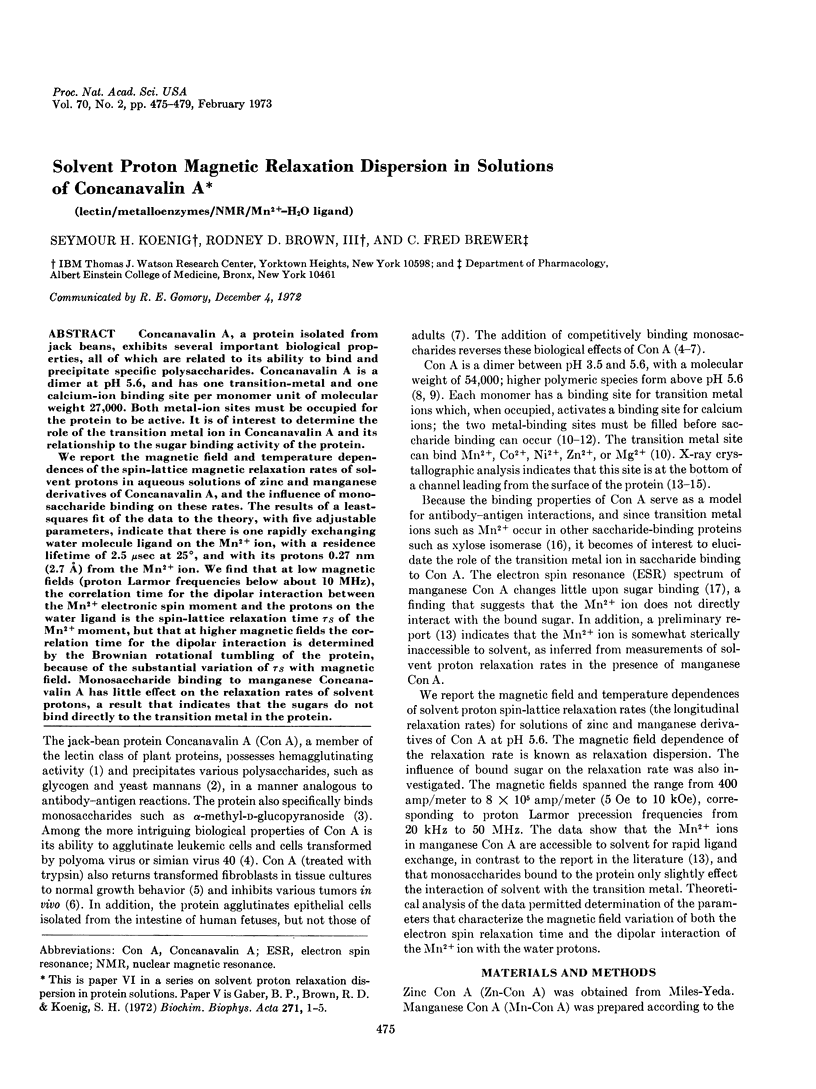
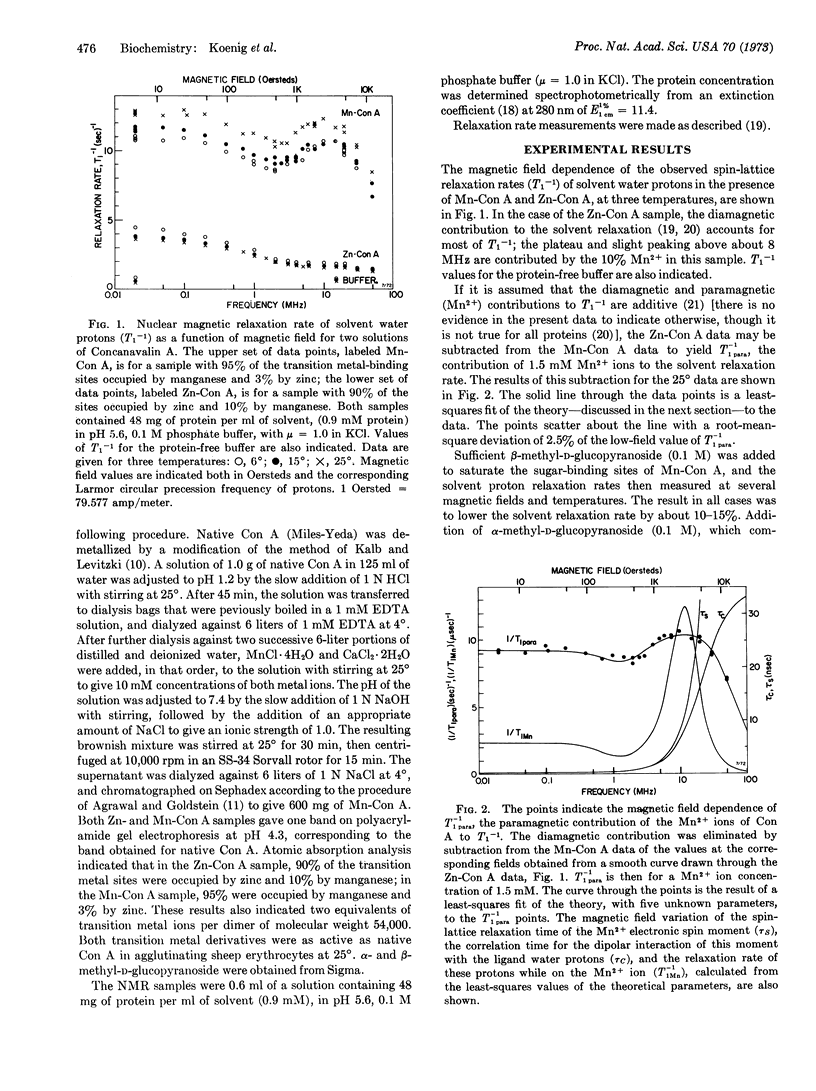
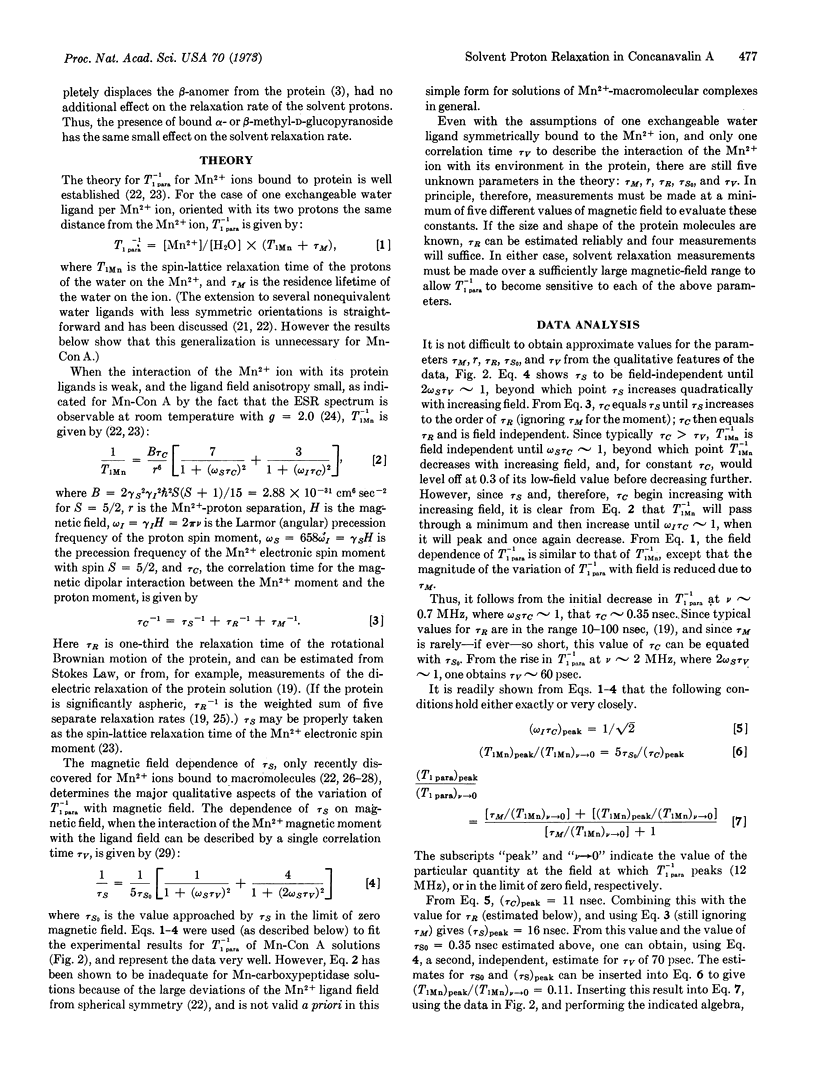
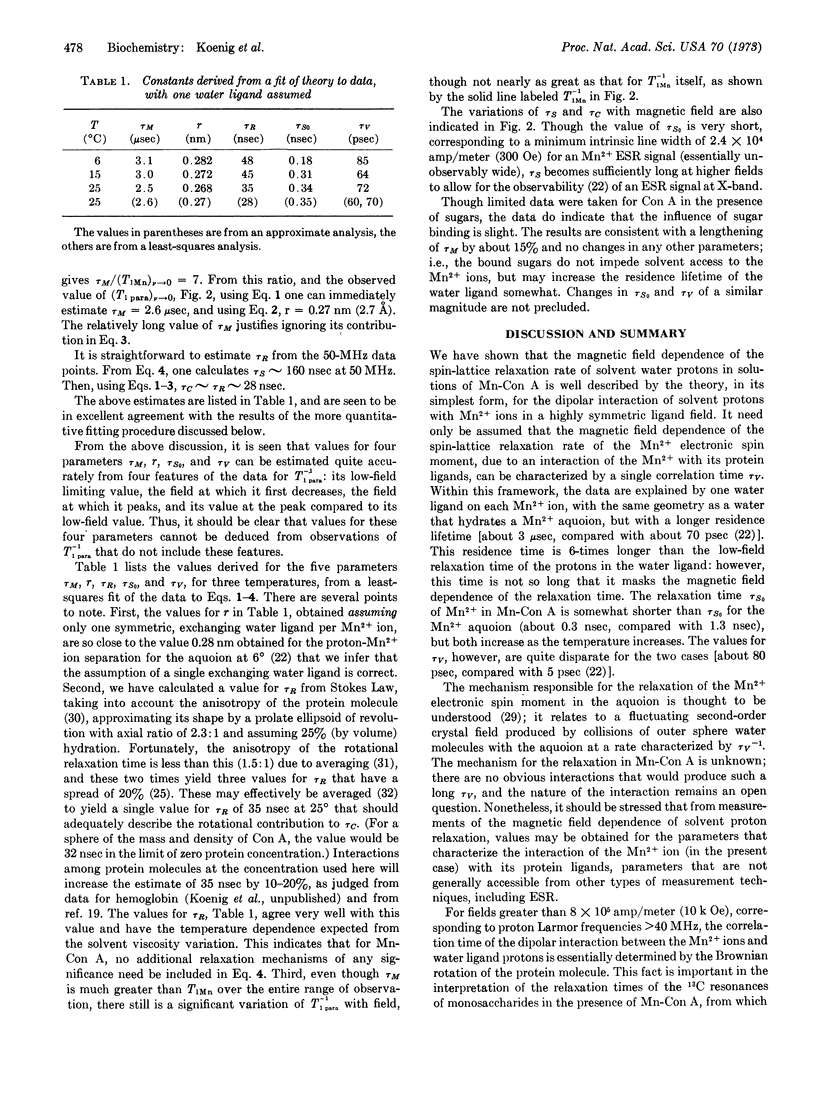
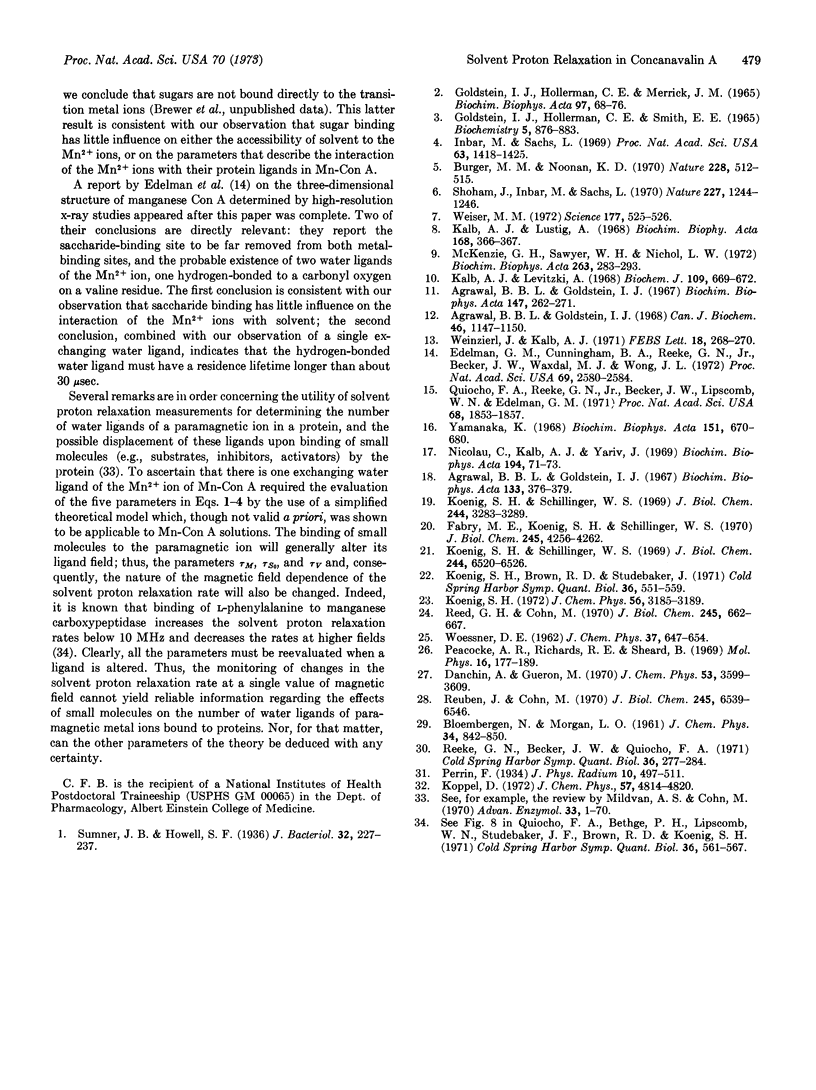
Selected References
These references are in PubMed. This may not be the complete list of references from this article.
- Agrawal B. B., Goldstein I. J. Physical and chemical characterization of concanavalin A, the hemagglutinin from jack bean (Canavalia ensiformis). Biochim Biophys Acta. 1967 Feb 21;133(2):376–379. doi: 10.1016/0005-2795(67)90081-5. [DOI] [PubMed] [Google Scholar]
- Agrawal B. B., Goldstein I. J. Protein-carbohydrate interactin. XV. The role of bivalent cations in concanavalin A-polysaccharide interaction. Can J Biochem. 1968 Sep;46(9):1147–1150. doi: 10.1139/o68-170. [DOI] [PubMed] [Google Scholar]
- Agrawal B. B., Goldstein I. J. Protein-carbohydrate interaction. VI. Isolation of concanavalin A by specific adsorption on cross-linked dextran gels. Biochim Biophys Acta. 1967 Oct 23;147(2):262–271. [PubMed] [Google Scholar]
- Burger M. M., Noonan K. D. Restoration of normal growth by covering of agglutinin sites on tumour cell surface. Nature. 1970 Nov 7;228(5271):512–515. doi: 10.1038/228512a0. [DOI] [PubMed] [Google Scholar]
- Danchin A., Guéron M. Proton magnetic relaxation study of the manganese-transfer-RNA complex. J Chem Phys. 1970 Nov 1;53(9):3599–3609. doi: 10.1063/1.1674538. [DOI] [PubMed] [Google Scholar]
- Edelman G. M., Cunningham B. A., Reeke G. N., Jr, Becker J. W., Waxdal M. J., Wang J. L. The covalent and three-dimensional structure of concanavalin A. Proc Natl Acad Sci U S A. 1972 Sep;69(9):2580–2584. doi: 10.1073/pnas.69.9.2580. [DOI] [PMC free article] [PubMed] [Google Scholar]
- Fabry M. E., Koenig S. H., Schillinger W. E. Nuclear magnetic relaxation dispersion in protein solutions. IV. Proton relaxation at the active site of carbonic anhydrase. J Biol Chem. 1970 Sep 10;245(17):4256–4262. [PubMed] [Google Scholar]
- GOLDSTEIN I. J., HOLLERMAN C. E., MERRICK J. M. PROTEIN-CARBOHYDRATE INTERACTION. I. THE INTERACTION OF POLYSACCHARIDES WITH CONCANAVALIN A. Biochim Biophys Acta. 1965 Jan 4;97:68–76. doi: 10.1016/0304-4165(65)90270-9. [DOI] [PubMed] [Google Scholar]
- GOLDSTEIN I. J., HOLLERMAN C. E., SMITH E. E. PROTEIN-CARBOHYDRATE INTERACTION. II. INHIBITION STUDIES ON THE INTERACTION OF CONCANAVALIN A WITH POLYSACCHARIDES. Biochemistry. 1965 May;4:876–883. doi: 10.1021/bi00881a013. [DOI] [PubMed] [Google Scholar]
- Inbar M., Sachs L. Interaction of the carbohydrate-binding protein concanavalin A with normal and transformed cells. Proc Natl Acad Sci U S A. 1969 Aug;63(4):1418–1425. doi: 10.1073/pnas.63.4.1418. [DOI] [PMC free article] [PubMed] [Google Scholar]
- Kalb A. J., Levitzki A. Metal-binding sites of concanavalin A and their role in the binding of alpha-methyl d-glucopyranoside. Biochem J. 1968 Oct;109(4):669–672. doi: 10.1042/bj1090669. [DOI] [PMC free article] [PubMed] [Google Scholar]
- Kalb A. J., Lustig A. The molecular weight of concanavalin A. Biochim Biophys Acta. 1968 Oct 21;168(2):366–367. doi: 10.1016/0005-2795(68)90161-x. [DOI] [PubMed] [Google Scholar]
- Koenig S. H., Brown R. D., Studebaker J. On the interpretation of solvent proton magnetic relaxation data with particular application to the structure of the active site of Mn-carboxypeptidase A. Cold Spring Harb Symp Quant Biol. 1972;36:551–559. doi: 10.1101/sqb.1972.036.01.069. [DOI] [PubMed] [Google Scholar]
- Koenig S. H., Schillinger W. E. Nuclear magnetic relaxation dispersion in protein solutions. I. Apotransferrin. J Biol Chem. 1969 Jun 25;244(12):3283–3289. [PubMed] [Google Scholar]
- Koenig S. H., Schillinger W. E. Nuclear magnetic relaxation dispersion in protein solutions. II. Transferrin. J Biol Chem. 1969 Dec 10;244(23):6520–6526. [PubMed] [Google Scholar]
- Mildvan A. S., Cohn M. Aspects of enzyme mechanisms studies by nuclear spin relazation induced by paramagnetic probes. Adv Enzymol Relat Areas Mol Biol. 1970;33:1–70. doi: 10.1002/9780470122785.ch1. [DOI] [PubMed] [Google Scholar]
- Nicolau C., Kalb A. J., Yariv J. Electron spin resonance study of the transition metal-binding site of concanavalin A. Biochim Biophys Acta. 1969 Nov 11;194(1):71–73. doi: 10.1016/0005-2795(69)90181-0. [DOI] [PubMed] [Google Scholar]
- Quiocho F. A., Bethge P. H., Lipscomb W. N., Studebaker J. F., Brown R. D., Koenig S. H. X-ray diffraction and nuclear magnetic resonance dispersion studies on derivatives of carboxypeptidase A. Cold Spring Harb Symp Quant Biol. 1972;36:561–567. doi: 10.1101/sqb.1972.036.01.070. [DOI] [PubMed] [Google Scholar]
- Quiocho F. A., Reeke G. N., Jr, Becker J. W., Lipscomb W. N., Edelman G. M. Structure of soncanavalin A at 4 A resolution. Proc Natl Acad Sci U S A. 1971 Aug;68(8):1853–1857. doi: 10.1073/pnas.68.8.1853. [DOI] [PMC free article] [PubMed] [Google Scholar]
- Reed G. H., Cohn M. Electron paramagnetic resonance spectra of manganese (II)-protein complexes. Manganese (II)-concanavalin A. J Biol Chem. 1970 Feb 10;245(3):662–664. [PubMed] [Google Scholar]
- Reeke G. N., Becker J. W., Quiocho F. A. The structure of concanavalin A at 4 A resolution. Cold Spring Harb Symp Quant Biol. 1972;36:277–284. doi: 10.1101/sqb.1972.036.01.037. [DOI] [PubMed] [Google Scholar]
- Reuben J., Cohn M. Magnetic resonance studies of manganese (II) binding sites of pyruvate kinase. Temperature effects and frequency dependence of proton relaxation rates of water. J Biol Chem. 1970 Dec 25;245(24):6539–6546. [PubMed] [Google Scholar]
- Shoham J., Inbar M., Sachs L. Differential toxicity on normal and transformed cells in vitro and inhibition of tumour development in vivo by concanavalin A. Nature. 1970 Sep 19;227(5264):1244–1246. doi: 10.1038/2271244a0. [DOI] [PubMed] [Google Scholar]
- Sumner J. B., Howell S. F. Identification of Hemagglutinin of Jack Bean with Concanavalin A. J Bacteriol. 1936 Aug;32(2):227–237. doi: 10.1128/jb.32.2.227-237.1936. [DOI] [PMC free article] [PubMed] [Google Scholar]
- Weinzierl J., Kalb A. J. The transition metal-binding site of concanavalin A at 2.8 A resolution. FEBS Lett. 1971 Nov 1;18(2):268–270. doi: 10.1016/0014-5793(71)80461-1. [DOI] [PubMed] [Google Scholar]
- Weiser M. M. Concanavalin A agglutination of intestinal cells from the human fetus. Science. 1972 Aug 11;177(4048):525–526. doi: 10.1126/science.177.4048.525. [DOI] [PubMed] [Google Scholar]
- Yamanaka K. Purification, crystallization and properties of the D-xylose isomerase from Lactobacillus brevis. Biochim Biophys Acta. 1968 Mar 25;151(3):670–680. doi: 10.1016/0005-2744(68)90015-6. [DOI] [PubMed] [Google Scholar]


